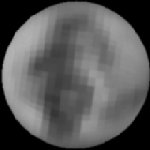|
Pluto
The
@stro object for the week of 01/24/2000

image
courtesy of STSI/HST
Pluto. Pluto
is our solar system's ninth planet and is named after the Roman
god of the underworld. Pluto is a small rocky body whose planetary
status in recent years has been questioned. Some astronomers wish
to classify it as a large minor planet (or asteroid) rather than
a planet. They have a case, but it was considered a planet since
its discovery and will likely remain so. Pluto, which has a diameter
of 2274km, is orbited by its own moon named Charon. Pluto is the
only planet in the solar system that has not yet been visited by
space probes. It rotates in about 6.3 days, has an orbital distance
from the Sun of 39 A.U. and takes about 248 years to complete one
orbit.
Discovered by
the late Clyde Tombaugh at the Lowell observatory in 1930, Pluto
is by far smaller than any of the other planets and is even smaller
than Earth's Moon. The search for Pluto
resulted from a discovery (which was later proven errant) that Neptune's
orbit had perturbations that couldn't be accounted for and a planetary
mass even farther than Neptune had to exist. This led to the search
that eventually turned up Pluto, even though Pluto's mass was later
found to be too small to account for the error. The real error came
from the original calculations for Neptune's mass, and if new figures
from Voyager 2 are used, the error in Neptune's orbit is non-existent.
more
info...
|